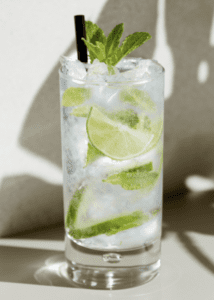Benefits Of Drinking Tonic Water – Tonic water has long been the basis of a happy hour, when vodka, gin, and other alcoholic beverages were melted down into simple cocktails with two ingredients. Outwardly, tonic-based drinks sound healthy. (You know, about something with alcohol). It doesn’t have the sugar bombs carried by margaritas and daiquiris, and its name suggests H20 — and we all know how important water is. Also, the word tonic just sounds healthy, right?
Contents
Benefits Of Drinking Tonic Water
Tonic water is a soft carbonated beverage that may be sugary and low in nutrients. The quinine present in tonic water gives it a distinct bitter taste. Although harmless, tonic water has benefits and can lead to a necessary increase in calorie consumption.
With the rise of shiny water and seltzer, many people are starting to wonder about tonic as a beverage outside of the hour of happiness, too. Pure water, seltzer, club soda, and tonic water all look the same; the drinks themselves may be clear but the difference between them is very confusing.

Benefits Of Drinking Tonic Water – Nutrients
The following nutritional information is provided by the USDA with a 12-ounce (366g) one tonic water supply.
- Calories: 114
- Fat: 0g
- Sodium: 40mg
- Carbohydrates: 30 g
- Fiber: 0g
- Sugar: 30g
- Protein: 0g
Nutritional benefits of drinking tonic water!
- Tonic water is a mixture of water containing carbonated, quinine, sugar, or corn froth high in fructose, and sometimes flavors.
- Ever heard of quinine? It is a bitter solution that forms in the crust of the cinchona plant. Cinchona plants are grown primarily in the Caribbean, South America, Central America, and parts of Africa.
- Initially, quinine was used in these regions as a treatment for malaria. But its bitter taste is what made it a popular tonic ingredient.
- The advantage of tonic water is that as it is a liquid, it can be hydrating.
- If you like to drink tonic water, like in your favorite cocktails, you enjoy it moderately.
- Calories in tonic water are derived from sugar. There are 33 grams of carbs and 32 g of sugar per bottle.
- The average glycemic load of tonic water is estimated to be four.
- Quinine, a key ingredient in warm water, can be used to treat malaria. The drug has been approved by the FDA for specific doses for treating the disease.
- But the amount of quinine in tonic water is less than what is commonly stated for therapeutic purposes.
- Some people may use tonic water to reduce stress. Tonic water is often mixed with gin to make a popular gin and tonic cocktail.
- Today, people sometimes drink tonic water to treat nighttime leg cramps associated with circulatory or neurological problems.
- For some, drinking tonic water is refreshing. You can enjoy it by mixing it with gin, vodka, and other spirits and using it as a cocktail.
- This alkaloid provides it with a bitter and astringent flavor. The husk of the Quinquina or Cinchona plant creates Quinine.
- Quinine is also available to relieve leg cramps.
- Quinine can be found to be effective in weight control.
- Tonic water has antipyretic properties.
- Studies have shown that quinine can reduce fever or prevent fever.
- When quinine is used before giving acetaminophen, as well as other drugs, a rapid decrease in body temperature occurs.
Summing up!
In a way, this beverage has an effect that can benefit our health. People in Europe, Scandinavia, Europe, and the United States sometimes mix tonic and espresso along with syrup to create a unique aftertaste. Gin tonic is one of the most common cocktails that use tonic water. Besides, it is an ingredient of many happy hours of alcohol. As you can see, the health and nutritional benefits of tonic water are very less. However, we say that, like most things in life, it can still be enjoyed in moderation. So if gin and tonics are your beverage choice, run for it. But if you want to make a difference in your health, you recommend that you take out your tonic to get fluid, carbonated fizz water — without sugar.